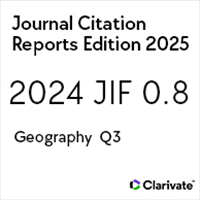Integración económica y su impacto en las organizaciones económicas transfronterizas: El caso de San Diego-Tijuana
Economic integration and cross-border economic organizations: The case of San Diego-Tijuana
https://doi.org/10.21670/ref.2017.35.a02
Palabras clave:
integración económica, economía fronteriza, ciclo económico, cooperación transfronteriza, organizaciones económicasResumen
La integración económica de los Estados Unidos y México ha afectado las relaciones económicas, políticas y sociales en la región fronteriza. Este trabajo busca relacionar la integración económica y la sincronización del ciclo económico de las ciudades de San Diego y Tijuana con el desarrollo de organizaciones económicas tanto a nivel nacional como binacional en la frontera. La metodología de análisis utiliza tanto estimaciones estadísticas como entrevistas semiestructuradas a organizaciones económicas con el fin de analizar la intensificación de la integración económica y los logros de las organizaciones económicas en la cooperación transfronteriza. Los resultados muestran que la cooperación transfronteriza ha estado controlada por organizaciones estatales y federales de ambos lados de la frontera. No obstante, los principales logros han sido realizados por organizaciones económicas privadas locales. Las perspectivas de mayor desarrollo económico dependen de la posibilidad de mayor involucramiento federal y de la promoción de organizaciones económicas locales.Abstract The economic integration between the United States and Mexico has affected the economic, political and social relations in the border region. The paper seeks to relate the increasing economic integration and business cycles of the economies of San Diego and Tijuana to the development of both national and binational economic organizations in the border region. The methodology of analysis uses both statistical estimations of the economic integration of San Diego and Tijuana and semi-structured interviews of economic organizations to analyze the increasing economic integration and the role and achievements of the cross-border economic organizations. The results showed that cross-border cooperation is predominately controlled by federal and state governments on both sides of the border. However, the main achievements of cross-border economic cooperation have been accomplished by local private organizations. The perspective of further local economic development greatly depends on both the possibility of increased involvement of federal governments and the growing encouragement of regional organizations.
Citas
Ackerman, E. (2011). NAFTA and gatekeeper: A theoretical assessment of border enforcement in the era of the neoliberal State. Journal of Sociology, 55, 40-56.
Alegría, T. (1990). Ciudad y transmigración en la frontera norte de México con los EUA. Frontera Norte, 2(4), 7-47.
Anderson, B. J. (2003). The U.S.-Mexico border: a half century of change. The Social Science Journal, 40(4), 535–554.
Brunet-Jailly, E., Payan, T. & Sawchuk, G. (2008). The emergence of cross-border regions along the Mexican-us Border and in Europe: Lessons for Canada (Working Paper Series 35). Canada: Government of Canada, Policy Research Initiative.
Bureau of Economic Analysis, United States Department of Commerce. (2015). Economic growth widespread across metropolitan areas in 2014. Retrieved from http://bea.gov/ newsreleases/regional/gdp_metro/gdp_metro_newsrelease.htm
Chang-Hee, C. B. (2005). Tijuana-San Diego: Globalization and the transborder metropolis. In H. W. Richardson & C. Bae (Edits.), Globalization and urban development (pp. 181-195). New York, United States of America: Springer.
Feinberg, R. E. & Schuck, G. (2001). San Diego, Baja California and globalization: Coming from behind. Los Angeles, United States of America: Pacific Council on International Policy.
Fullerton, T. M. (2003). Recent trends in border economics. The Social Science Journal, 40(4), 583-592.
Hanson, G. (1996). Localization economies, vertical organization, and trade. American Economic Review, 86(5), 1266-1278.
Herzog, L. A. & Sohn, C. (2014). The cross-border metropolis in a global age: A conceptual model and empirical evidence from the U.S.-Mexico and European border regions. Retrieved from http://www.tandfonline.com/10.1080/13600826.2014.948539
Instituto Nacional de Estadística y Geografía (Inegi). (2009). Encuesta Nacional de Ocupación y Empleo (ENOE) población de 15 años y más edad. Retrieved from http://www. beta.inegi.org.mx/proyectos/enchogares/regulares/enoe/
Instituto Nacional de Estadística y Geografía (Inegi). (2013). Censos y conteo de población y vivienda. Serie Histórica Censal e Intercensal, 2010. Retrieved from http://www.inegi.org.mx/est/lista_cubos/consulta.aspx?p=pob&c=6
Instituto Nacional de Estadística y Geografía (Inegi). (2014). Censos económicos 2014. Resultados definitivos. Retrieved from http://www.inegi.org.mx/est/contenidos/proyectos/ce/ce2014/default.aspx#Mas
Instituto Nacional de Estadística y Geografía (Inegi). (n.d.). Gross domestic product by state. Retrieved from http://www.inegi.org.mx/sistemas/bie/
International Trade Administration, Department of Commerce. (2011). San Diego-Carlsbad-San Marcos, CA.
Kada, N. & Kiy, R. (2004). Blurred borders: Trans-boundary impacts & solutions in the San Diego-Tijuana border region. International Community Foundation. Retrieved from http://www.borderhealth.org/files/res_874.pdf
Koslwski, R. (2011). The evolution of the border controls as a mechanism to prevent illegal immigration. Migration Policy Institute. Retrieved from http://www.migrationpolicy.org/research/evolution-US-border-controls-illegal-immigration
Krugman, P. (1991). Increasing returns and economic geography. Journal of Political Economy, 99(3), 483-499.
Mendoza, J. E. (2007). Integración económica, ingresos y empleo en las ciudades fronterizas de México y los Estados Unidos en la década de los noventa. En J. E. Mendoza (Coord.), El TLCAN y la frontera México-Estados Unidos, aspectos económicos (pp. 17-53). El Colef, Miguel Ángel Porrúa.
Mendoza, J. E. (2013). US-Mexican economic integration and its effects on the unemployment in Mexico’s northern border states. Journal of Borderlands Studies, 28(1), 93-108.
Muria, M. & Chavez, S. (2011). Shopping and working in the borderlands: enforcement, surveillance and marketing in Tijuana, Mexico. Surveillance and Society, 8(3), 355- 373.
Niebuhr, A. & Stiller, S. (2002). Integration effects in border regions, a survey of economic theory and empirical studies (Discussion Paper 179). Germany: Hamburg Institute of International Economics, HWWA.
San Diego Association for Governments (SANDAG). (2012). Traded industry clusters in the San Diego region. Retrieved from http://www.sandag.org/uploads/publicationid/publicationid_1715_15318.pdf
San Diego Association for Governments (SANDAG). (2015). About SANDAG Committee on binational Regional Opportunities. Retrived from http://www.sandag.org/index.asp?committeeid=34&fuseaction=committees.detail
Sassen, S. (2000). The global city: Strategic site/new frontier. American Studies, 41(2/3), Globalization, transnationalism, and the end ofthe american century (Summer/Fall, 2000), 79-95. Retrieved from http://www.jstor.org/stable/40643231
Schmidt, C. (2004). The analysis of semi-structured interviews. In U. Flick, E. V. Kardorff & I. Steinke S. (Eds.), A Companion to qualitative research (pp. 253-259). London: SAGE Publications.
Secretaría de Desarrollo Económico de Baja California (Sedeco). (n.d.). Semáforo económico estado de Baja California. Retrieved from http://sedeco.regionescompetitivas.com/SEDECO/
Sparrow, G. (2001). San Diego-Tijuana: Not quite a binational city or region. GeoJournal, 54(1), 73-83.
Taylor, L. D. (2007). NGO Transborder organizations San Diego-Tijuana and Vancouver-Seattle regions. Frontera Norte, 19(37), 35-57.
United States Census Bureau. (n.d.). 2008-2012 American Community Survey. Retrived from https://www.census.gov/acs/www/data/data-tables-and-tools/index.php
United States Department of Labor, Bureau of Labor Statistics. (n.d.). Bureau of Labor, databases, tables & calculators by subject. Retrieved from http://www.bls.gov/data/#employment
United States Department of Transportation, Office of the Assistant Secretary for Research and Technology, Bureau of Transportation Statistics, TransBorder Freight Data. (n.d.). North American transborder freight data, including port, commodity, or state origin/destination. Retrieved from http://transborder.bts.gov/programs/international/transborder/TBDR_QA.html
United States Department of Transportation. (n.d.). Border crossings/entry data: Time series analysis. Retrieved from http://transborder.bts.gov/programs/international/transborder/TBDR_BC/TBDR_BCTSA.html
Vargas-Hernández J. & Reza, N. M. (2010). An exploration of Tijuana-San Diego marketing environment. International Business Research, 3(2), 162-168.
































